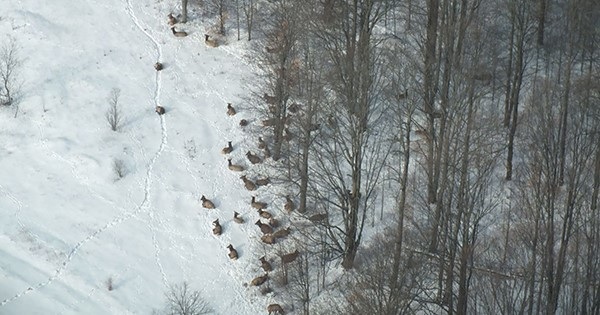
The 2018 elk hunting season stats are in, and the 2019 winter elk survey just wrapped up, providing a clear picture of where Michigan’s elk population currently stands.
Hunt period 1, which targets elk outside of their traditional range, was 12 days long. From Aug. 28-31, Sept. 14-17 and Sept. 28-Oct. 1, 99 state hunters harvested 68 elk (28 bulls and 40 antlerless elk.) In addition, all three Pure Michigan Hunt winners were successful during the first hunt period.
During hunt period 2, Dec. 15-23, another 100 state hunters harvested 78 elk (30 bulls and 48 antlerless elk). All locations in the northern tip of the state are open to hunting for this later hunt.
In order for regulated hunting to assist in managing elk, Michigan’s elk population first must be evaluated.
“Our population goal for elk is between 500 and 900 animals. This has been determined as the best balance for the forests, area agriculture and residents,” Michigan Department of Natural Resources elk specialist Chad Stewart said. “Besides having an estimated population, knowing where they are located is also very important.”
An aerial survey occurs in January, with a DNR airplane flying predetermined routes, or transects, to locate elk. Once elk are found, the plane circles, and observers count how many are present and determine the number of males and females in the group.
Most of the elk population can be found within or adjacent to the elk range in the northeast Lower Peninsula. The Pigeon River Country State Forest makes up a large area of the elk range, and fields are planted and mowed to attract elk from the surrounding private land.
“We try to lure elk away from agriculture using different techniques to modify the forest,” Stewart said. “We try to encourage elk to hang out in those modified locations.”
More than 8,700 miles of transects were flown in nine days during the 2019 survey, with 834 elk sighted. No wildlife survey can count 100 percent of the animals because they move and are often under cover like trees, so a formula is used to establish a population estimate. Other states use similar formulas during wildlife surveys. The 2019 aerial survey determined an estimated elk population of approximately 1,196 elk, with a confidence interval of plus or minus 266.
“The survey tells us there are between 930 and 1,462 elk in Michigan,” DNR Wildlife Field Operations Manager Brian Mastenbrook said. “Based on this survey, past surveys, damage concerns and disease issues, we will continue to reduce the elk population slowly over the coming years with our regulated hunting seasons.”
The Natural Resources Commission has exclusive authority to regulate the taking of game.
The aerial elk survey takes place in January, when there is snow on the ground and leaves are off the trees, both conditions that allow the best view of elk from above. It is also after the elk hunting season is complete and before young elk are born, therefore the lowest point in the population during the year.
Additional information about elk and elk hunting in Michigan can be found at Michigan.gov/Elk.
/Note to editors: Contact – Brian Mastenbrook, 989-732-3541. An accompanying photo is available below for download. Caption information follows.
Elk survey: The Department of Natural Resources estimates Michigan’s population of elk and where they are found in the northern Lower Peninsula through an aerial survey./
Related articles
